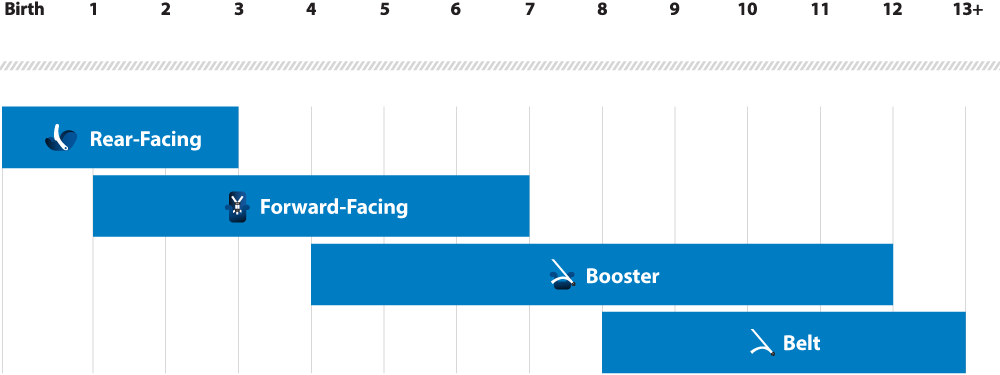Georgia Car Seat Safety Guide
With more than 2,600 children under 13 involved in a car crash every day, or one child every 33 seconds, parents need to be extra vigilant about keeping kids safe in cars. And while most families put kids in car seats, the latest research from the National Highway Traffic Safety Administration (NHTSA) shows that nearly 60 percent of car seats are installed or adjusted incorrectly.
What does Georgia law say about Child Passenger Safety?
In Georgia, there is legislation to ensure children are riding in child passenger restraint systems while in a passenger motor vehicle. According to O.C.G.A. 40-6-76 (Georgia Code) children under eight years of age must ride in an approved child restraint system and be restrained by a seat safety belt approved under Federal Motor Vehicle Safety Standard 208 .
It is very important for parents and caregivers to understand that while the law is important to know, it is also critical to understand what is best practice for children who ride in car seats and knowing the appropriate car seat to use.
Best Practices in Child Passenger Safety
- Visit a Child Safety Seat Fitting Location in Georgia
- Find a local Child Passenger Safety Technician
*Disclaimer: For the most updated information, please contact safekidsgeorgia@choa.org
- Keep your child rear-facing as long as possible.
- Select a car seat based on your child’s age and size, choose a seat that fits in your vehicle, and use it every time.
- Always refer to your specific car seat manufacturer’s instructions (check height and weight limits) and read the vehicle owner’s manual on how to install the car seat using the seat belt or lower anchors and a tether, if available.
- To maximize safety, keep your child in the car seat for as long as possible, as long as the child fits within the manufacturer’s height and weight requirements.
- Keep your child in the back seat at least through age 12.
 (Image courtesy of nhtsa.gov)
(Image courtesy of nhtsa.gov)
12 Years and Under
Birth – 12 Months
Your child under age 1 should always ride in a rear-facing car seat. The American Academy of Pediatrics recommends that children ride rear facing for at least 2 years to protect their neck from injury in case of a car crash. There are different types of rear-facing car seats: Infant-only seats can only be used rear-facing. Convertible and 3-in-1 car seats typically have higher height and weight limits for the rear-facing position, allowing you to keep your child rear-facing for a longer period of time.
1 – 3 Years
Keep your child rear-facing as long as possible. It’s the best way to keep him or her safe. Your child should remain in a rear-facing car seat until he or she reaches the top height or weight limit allowed by your car seat’s manufacturer. Once your child outgrows the rear-facing car seat, your child is ready to travel in a forward-facing car seat with a harness.
4 – 7 Years
Keep your child in a forward-facing car seat with a harness until he or she reaches the top height or weight limit allowed by your car seat’s manufacturer. Once your child outgrows the forward-facing car seat with a harness, it’s time to travel in a booster seat, but still in the back seat.
8 – 12 Years
Keep your child in a booster seat until he or she is big enough to fit in a seat belt properly. For a seat belt to fit properly the lap belt must lie snugly across the upper thighs, not the stomach. The shoulder belt should lie snug across the shoulder and chest and not cross the neck or face. Remember: your child should still ride in the back seat because it’s safer there. Typically, children can’t graduate out of booster seats until they are at least 4 foot, 9 inches to make sure seat belt fits properly.
Children Using Booster Seats Are 59 Percent Less Likely To Be Injured In A Crash Than Those Using A Seat Belt Alone.
Links for Resources Georgia Child Passenger Safety Law // Child Passenger Safety Best Practices // Child Passenger Safety Frequently Asked Questions // Contact GOHS
The Ultimate Car Seat Guide from Safe Kids Worldwide
The Ultimate Car Seat Guide gives parents and caregivers practical tips to keep kids safe in cars. Having worked one-on-one with millions of parents, coalition and staff experts offer best practices to give caregivers the best way to protect kids in cars at any age, from birth to booster seat. We have tips that make car seat buying, installing, fitting and changing easier to understand. The tool is not intended to take the place of a Child Passenger Safety Technician, reading labels or following manufacturer instructions. But there are many people who just can’t get to a car seat event or inspection station. This website is designed so we can raise awareness and reach as many people as possible with helpful information to keep kids safe in cars. Because most families will access the website on their phones, the information needs to be short and easy to understand. The Ultimate Car Seat Guide is a web app, meaning you simply visit a website to access it; no need to download anything. It is always available even if they change or lose a phone.
Join us on Facebook



